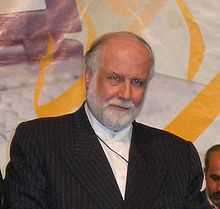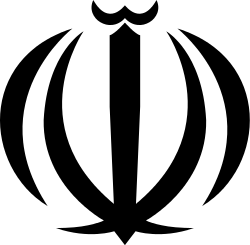Hassan Habibi
| Hassan Ebrahim Habibi حسن ابراهیم حبیبی | |
|---|---|
 | |
| First Vice President of Iran | |
| In office 1 September 1989 – 11 September 2001 | |
| President | Akbar Hashemi Rafsanjani Mohammad Khatami |
| Succeeded by | Mohammad-Reza Aref |
| Minister of Justice | |
| In office 9 March 1985 – 1 September 1989 | |
| President | Ali Khamenei |
| Prime Minister | Mir-Hossein Mousavi |
| Preceded by | Mohammad Asghari |
| Succeeded by | Esmail Shooshtari |
| Minister of Science | |
| In office 6 October 1979 – 29 October 1981 | |
| President | Abulhassan Banisadr Mohammad-Ali Rajai |
| Prime Minister | Mohammad-Ali Rajai Mohammad-Javad Bahonar Mahdavi Kani (Acting) |
| Preceded by | Ali Shariatmadari |
| Succeeded by | Hassan Arefi |
| Minister of Culture | |
| In office 1 October 1979 – 6 November 1979 | |
| Prime Minister | Mehdi Bazargan |
| Preceded by | Abbas Dozdozani |
| Succeeded by | Nasser Minachi |
| Personal details | |
| Born | 29 January 1937 Tehran, Iran |
| Died | 31 January 2013 (aged 76) Tehran, Iran |
| Political party | Executives of Construction Party (1993-2013) |
| Other political affiliations |
Islamic Republican Party (1979-1987) Freedom Movement (1966-1979) |
| Spouse(s) | Shafigheh Rahideh[1] |
| Religion | Islam |
Hassan Ebrahim Habibi (29 January 1937 – 31 January 2013) was an Iranian politician, lawyer, scholar and the head of Academy of Persian Language and Literature (from 11 October 2004 to his death in 2013). He was also a member of the High Council of Cultural Revolution. Habibi was the first vice president of the Islamic Republic of Iran.
Early life and education
Habibi was born on 29 January 1937. He studied sociology in France.[2][3] He held a PhD in law and sociology. When he was a university student he visited Khomeini while the latter was in exile.[4]
Career
Habibi was tasked by Ayatollah Khomenei to draft the prospective constitution of Iran when the latter was in exile in Paris.[5] His version was heavily modified due to criticisms and the final text was approved by the election in November 1979.[3]
Following the Iranian revolution, Habibi was named public spokesman for the revolutionary council.[6] He was among the main architects of the first draft of Constitution of the Islamic Republic of Iran, which was later passed for more discussion to an elected Assembly of Experts for Constitution.[7] The assembly made significant changes in the original draft, e.g. by introducing the new position of "leader of the Islamic Republic" based on Khomeini's concept of Guardianship of the Islamic Jurists, which gave almost unlimited power to the clergy. The modified version was approved in a popular referendum in 1979. In the 1980 presidential election, Habibi run for office, but received only ten percent of the vote against Banisadr's seventy percent.[8] Habibi was backed by Mohammad Beheshti in the election process.[8] In the same year he won a parliamentary seat, being a representative of the Islamic Republican Party.[9]
Habibi served as the minister of justice under Prime Minister Mousavi. He was first vice president of Iran from 1989 to 2001, eight years under President Rafsanjani and then four years under President Khatami.[7] He was replaced by Mohammad Reza Aref in the post in Khatami's second term. He was also head of the Academy of Persian Language and Literature[10] and a member of the Expediency Council.[11]
Death
Habibi died on 31 January 2013. He was buried at the mausoleum of Imam Khomeini in Tehran on 1 February.[11] The funeral service was attended by leading Iranian political figures, including former President Ahmedinejad.[11]
Work
Habibi is the author of several books, including God (1981), Society, Culture, Politics (1984), Islam and the Crisis of Our Time (1984), In the Mirror Of Rights: Views Of International Rights, Comparative Rights And Sociology (1988), Seeking the Roots (editing & translation) (1994), Casework of An Ages Student (1997), One Word Out Of Thousands (2 vol.) (1998-2001) and General International Rights (2 vol.) (2003).[12]
References
- ↑ Dana Dabir (7 March 2011). همسران حکومتی؛ از حاشیه تا متن [Governmental spouses; from the margin to the text]. Khodnevis (in Persian). Retrieved 7 March 2011.
- ↑ Chehabi, H. E. (Summer 1991). . "Religion and Politics in Iran: How Theocratic Is the Islamic Republic?". Daedalus 120 (3): 69–91. Retrieved 5 August 2013.
- ↑ 3.0 3.1 Randjbar-Daemi, Siavush (2013). "Building the Islamic State: The Draft Constitution of 1979 Reconsidered". Iranian Studies 46 (4): 641–663. doi:10.1080/00210862.2013.784519. Retrieved 21 August 2013.
- ↑ Paola Rivetti (February 2012). "Islamic Republic: Shaping Iran's politics through the campus". In Rouzbeh Parsi. Iran: A Revolutionary Republic in Transition (CHAILLOT PAPERS). Paris: Institute for Security Studies European Union. ISBN 978-92-9198-198-4. Retrieved 27 July 2013.
- ↑ Akhavi, Shahrough (2008). "The Thought and Role of Ayatollah Hossein'ali Montazeri in the Politics of Post-1979 Iran". Iranian Studies 41 (5): 645–666. doi:10.1080/00210860802518301. Retrieved 19 August 2013.
- ↑ Rubin, Barry (1980). Paved with Good Intentions (PDF). New York: Penguin Books. p. 284.
- ↑ 7.0 7.1 "Hassan Ebrahim Habibi, Iranian scholar & former VP passes away". PressTV. 1 February 2013. Retrieved 2 February 2013.
- ↑ 8.0 8.1 Rouleau, Eric (1980). "Khomenei's Iran". Foreign Affairs 59 (1). Retrieved 5 August 2013.
- ↑ Bahman Baktiari (1996). Parliamentary Politics in Revolutionary Iran: The Institutionalization of Factional Politics. Gainesville, FL: University Press of Florida. p. 69. – via Questia (subscription required)
- ↑ "Iranologists condemn deliberate distortion of Persian Gulf's name". Payvand. 24 December 2004. Retrieved 6 August 2013.
- ↑ 11.0 11.1 11.2 "Iran's former first vice president laid to rest". Tehran Times. 1 February 2013. Retrieved 6 August 2013.
- ↑ "Dr. Hassan Habibi". Eve Literary Agency. Retrieved 2 February 2013.
| Political offices | ||
|---|---|---|
| Preceded by Office established |
First Vice President of Iran 1989–2001 |
Succeeded by Mohammad-Reza Aref |
| ||||||||
| ||||||||||||||||||||||||||||||||||||||||||||||||||||||||||||||||||||||||||||||||||||||||||||||||||||||||||||||||||||||

